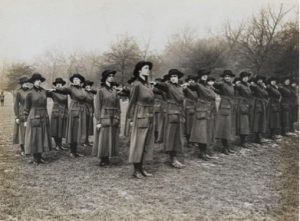Queen Mary’s Army Auxiliary Corps (1917-1919 and 1939-1945)
“The women were soldiers, and their deaths were only to be expected.” – QMAAC, 1917
The Women’s Army Auxiliary Corps (WAAC) established during World War I (1917), employed women on both the home front and the front lines. Named Queen Mary’s Army Auxiliary Corps in 1918 and disbanded in 1921, the corps was reinstated during World War II as the Auxiliary Territorial Service. The beginning of World War I saw many pre-war women’s organizations like the suffrage movements abandoning their fight to support the men and their country in the war. As one British newspaper headline read, “The British Lion is awake, so is the Lioness.”
World War I saw still relatively distinct gender lines. Men were sent to the battlefields and women were left at home. However, World War II broke the clear line between home and battlefield as more civilians died than soldiers and both men and women were involved as workers, combatants, and perpetrators to violence. Women played a much larger role on the battlefield fighting alongside men during World War II than in World War I Yet, by the end of both world wars, society did not celebrate women for their actions; instead, women often faced hostility for deviating from the feminine roles of wives, mothers, and protectors of the home.
The British military leadership founded three women’s auxiliary services as World War I causalities continued to rise. Among the three auxiliary services founded was the Women’s Army Auxiliary Corps. During World War II, according to historian Ann T. Allen, women volunteers in the global WAAC performed non-combat tasks, working “clerks, cooks, electricians, code breakers, and ambulance drivers (to mention only a few).” The idea of employing women in non-combat roles was to take over male jobs so that these men could deploy to the front lines. The WAAC poster below states, “Every fit woman can release a fit man,” illustrating the role that women in the Women’s Army Auxiliary Corps occupied. Although the women in the WAAC wore a type of military uniform and existed under a military institution, the armed services went to great lengths to ensure the WAAC was not a combat organization. The Women’s Army Auxiliary Corps was renamed the Queen Mary’s Army Auxiliary Force in 1918 and later disbanded in 1921. However, by World War II, the attitudes towards women occupying combat roles had changed.
World War II cut down the clear-cut lines of the home front and the battlefield. Civilian causalities arose compared to soldier causalities and the military recruited more women to boost its strength. At this time, Britain was under constant attack from German bombers and Prime Minister Winston Churchill was open to recruiting women to defend the homeland. Throughout World War II, according to Allen, “125,000 women were drafted into the military by the National Service Act and 430,000 more volunteered.” In the beginning of the war, Women’s roles were much like their roles during World War I. In 1938, according to an article in the Women’s Studies International Forum, the Auxiliary Territorial Service (ATS) was created, which defined women’s service as “strictly voluntary and non-combatant.”
However, by 1941, according to historian Gisela Block, women in Britain within a certain age range were required to register and “compulsory conscription was intensified up to 1943.” Women moved into combatant roles and served in mixed anti-aircraft units that shot down their first German plane on November 21, 1941. Although these women were serving on the home front, they were in harm’s way because enemy planes aimed for anti-aircraft units, especially the searchlights that women controlled. Throughout the war, according to Allen, “389 British women were killed or wounded in action,” but just as in World War I, “the women were soldiers, and their deaths were only to be expected.” Although, British women fought and defended their nation, the members of the women’s armed services faced hostility. Despite their service, people did not celebrate them because they deviated from societal perceptions of women as mothers and protectors of the home.
During and after both world wars, the reception towards women who belonged to the auxiliary services was negative. Many believed that these women associated too freely with men and gained a reputation for sexual promiscuity. The British public denied these women, according to Allen, “praise that was lavished on their male counterparts.” The use of women in the military upset the traditional standards of behavior and societal norms during a time of turmoil that already caused many changes. Even without the devastation of war, employing women in the military would have been seen as unacceptable by many in society. So, the actions of these women were swept under the rug.
The Women’s Army Auxiliary Corps and the Auxiliary Territorial Service gives us a glimpse into what roles women occupied in the early stages of women integration into the armed forces. Today, we have many women around the world that serve in the armed forces and these auxiliary services during the world wars provide us the knowledge on how women’s roles in the military transgressed from fighting behind the front lines in several different sectors to fighting at the front lines, and the societal norms that they challenged by doing so.
Kayla Travis, Exercise and Sport Science major and History minor, Class of 2018
Sources
Literature and Websites
- “Women’s Army Auxiliary Corps.” East Sussex County Council. http://www.eastsussexww1.org.uk/womens-army-auxiliary-corps/ (Accessed April 15, 2018)
- Allen, Ann T. Women in Twentieth-Century Europe. Basingstoke and New York: Palgrave MacMillan, 2007.
- Block, Gisela. Women in European History. Oxford: Blackwell, 2002.
- Fieseler, Beate, M. Michaela Hampf, and Jutta Schwarzkopf. “Gendering Combat: Military Women’s status in Britain, the United States, and the Soviet Union during the Second World War.” Women’s Studies International Forum, 47 (2014): 47: 115-126.
Images




